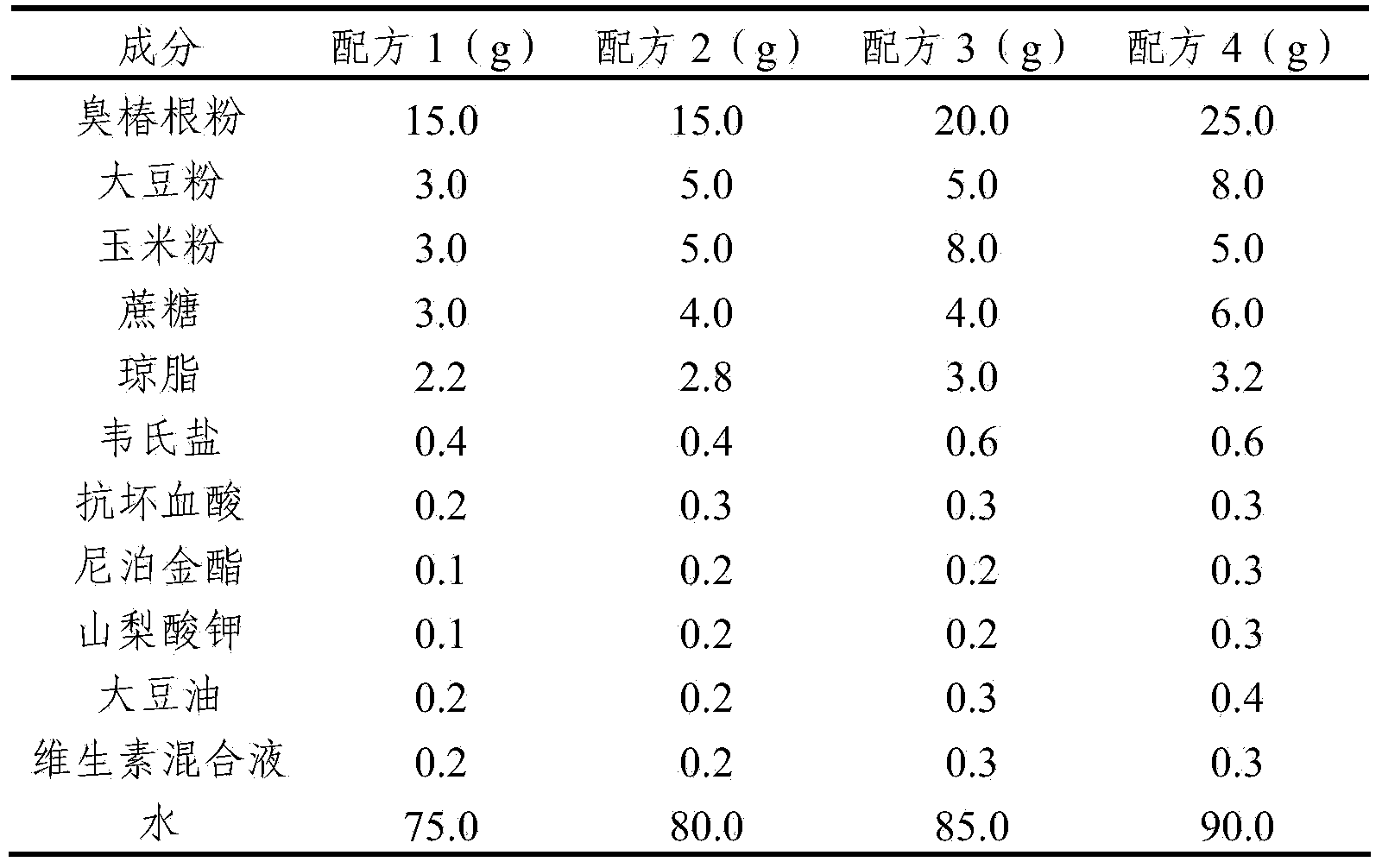Semi-artificial feed for eucryptorrhynchus chinenis and artificial breeding method
An artificial and artificial technology, applied in the field of biological control of forest pests, can solve problems such as shortage of seasonal host feeding and feed, and achieve the effects of low price, remarkable benefit and high survival rate.
- Summary
- Abstract
- Description
- Claims
- Application Information
AI Technical Summary
Problems solved by technology
Method used
Image
Examples
Embodiment 1
[0046] Table 1: The weight ratio of each substance in different formulas of the semi-artificial diet for the larvae
[0047]
[0048] 4 kinds of formulas shown in table 1 are prepared into feed medium according to the following steps,
[0049] (1) Fully mix Ailanthus sinensis root powder, soybean flour, corn flour and sucrose to make a mixed powder, and at the same time dissolve sucrose, Webster's salt, ascorbic acid, paraben, potassium sorbate, soybean oil and multivitamin In water, stir and mix to make a mixed solution;
[0050] (2) Add water to the container, heat to boil, add agar, after the agar is completely melted, add the mixture, stir to dissolve;
[0051](3) Slowly add the mixed powder and stir well to mix evenly;
[0052] (4) Stop heating, divide into petri dishes while hot, compact and dry the surface moisture naturally, store at 5°C after cooling for later use, and prepare feed medium.
Embodiment 2
[0054] Select 40 chrysalis pupae, and 37 eclosion adults under the conditions of temperature 25-28°C and humidity 70-80%. Pair the adult moths with a male-to-female ratio of 1:1, put them into a plastic box with a diameter of 12 cm, and feed them on the branches and leaves of Ailanthus ailanthii for 10 days, and then put in sliced apples with a thickness of 1 cm. A pair of adults per box, 3 ~ 7 days after laying eggs, 380 eggs are laid, and the egg period is 10 days. After routine disinfection, they were placed at 25°C, and 345 larvae were hatched.
[0055] Configure the semi-artificial feed according to formula 1, pack it into plastic petri dishes, insert the newly hatched larvae (each container inserts 1 head), put them into a constant temperature incubator, and place them in the dark for rearing. Depending on the feeding situation, the feed was changed at regular intervals. After 2 weeks, 200 larvae survived, and 144 larvae pupated after 103 days. The pupae were transfe...
Embodiment 3
[0057] Select 60 chrysalis pupae, and 45 eclosion adults under the conditions of temperature 25-28°C and humidity 65-85%. Put the adult moths into a plastic box with a diameter of 12 cm according to the ratio of male to female in a ratio of 1:1, and feed them on the branches and leaves of Ailanthus ailanthii for 10 days, and then put in sliced apples with a thickness of 1 cm, a pair of adults per box, After 3 to 7 days, eggs were laid, 460 eggs were laid, and the egg period was 11 days. Routine disinfection (first sterilized with 75% alcohol for 10 seconds, and then rinsed twice with sterile water) was placed at 28°C, and 403 larvae were hatched. .
[0058] Configure the semi-artificial feed according to formula 2, pack it into plastic petri dishes, insert the newly hatched larvae (each container inserts 1 head), put them into a constant temperature incubator, and place them in the dark for rearing. Depending on the feeding situation, the feed was changed at regular interva...
PUM
 Login to View More
Login to View More Abstract
Description
Claims
Application Information
 Login to View More
Login to View More - R&D
- Intellectual Property
- Life Sciences
- Materials
- Tech Scout
- Unparalleled Data Quality
- Higher Quality Content
- 60% Fewer Hallucinations
Browse by: Latest US Patents, China's latest patents, Technical Efficacy Thesaurus, Application Domain, Technology Topic, Popular Technical Reports.
© 2025 PatSnap. All rights reserved.Legal|Privacy policy|Modern Slavery Act Transparency Statement|Sitemap|About US| Contact US: help@patsnap.com



